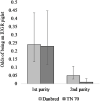Characteristics of Piglets Born by Two Highly Prolific Sow Hybrids
- PMID: 32671111
- PMCID: PMC7326779
- DOI: 10.3389/fvets.2020.00355
Characteristics of Piglets Born by Two Highly Prolific Sow Hybrids
Abstract
High piglet mortality constitutes a welfare challenge in Danish organic pig production with almost one in three piglets dying before weaning. Piglet characteristics such as birth weight, rectal temperature and intrauterine growth restriction (IUGR) affect piglet survival. Due to differences in breeding goals, these characteristics may be expected to differ between sow hybrids. Thus, the aims of the present study were (1) to investigate piglet characteristics in two highly prolific sow hybrids and (2) to study to which extent the aforementioned characteristics affect piglet mortality. Forty-nine sows (22 DanBred and 27 Topigs Norsvin) were followed in their first two parities. Sows were housed outdoors and gave birth in huts. On day 1 postpartum ( pp ) piglets were individually marked, weighed, their rectal temperature was recorded and they were scored for IUGR. Weight and rectal temperature were recorded again 3 days pp. Principal component analyses were conducted to explore relationships among variables. Early piglet death grouped with IUGR, lower rectal temperature and weight on day 1 pp. Late mortality grouped with increasing litter size and DanBred hybrid. Whilst, Topigs Norsvin hybrid grouped with increasing rectal temperature day 3 pp, longer crown to rump length, higher weight and more teats on the sow. Results of the statistical analyses showed that Topigs Norsvin piglets were heavier 1 and 3 days pp (p < 0.001) compared to DanBred piglets. Furthermore, Topigs Norsvin piglets had a higher rectal temperature than DanBred on day 1 pp (p = 0.023). The risk of IUGR depended on an interaction between sow hybrid and parity (p = 0.023). DanBred sows gave birth to more piglets (18.2 ± 0.6) than Topigs Norsvin sows (15.7 ± 0.5, p = 0.003), however, DanBred sows had fewer teats than Topigs Norsvin sows. Weight on day 1 pp affected both the odds of stillbirth (p < 0.001) and live born death (p < 0.001). Lower rectal temperature day 1 pp (p < 0.001) increased the odds of live born death. In conclusion, the investigated hybrids differed in several piglet characteristics related to piglet mortality. Use of sows giving birth to heavier and fewer piglets in the litter may thus be a useful tool to reduce piglet mortality in pig production with outdoor farrowing.
Keywords: animal welfare; lactating sows; organic pig production; outdoor farrowing; piglet mortality; piglet viability; sow genetics; sow parity.
Copyright © 2020 Schild, Foldager, Rangstrup-Christensen and Pedersen.
Figures





References
-
- Prunier A, Lubac S, Mejer H, Roepstorff A, Edwards S. Health, welfare and production problems in organic suckling piglets. Org Agric. (2014) 4:107–21. 10.1007/s13165-013-0052-0 - DOI
-
- Prunier A, Dippel S, Bochicchio D, Edwards SA, Leeb C, Lindgren K, et al. Characteristics of organic pig farms in selected European countries and their possible influence on litter size and piglet mortality. Org Agric. (2014) 4:163–73. 10.1007/s13165-013-0040-4 - DOI
-
- Baxter EM, Jarvis S, Sherwood L, Robson SK, Ormandy E, Farish M, et al. Indicators of piglet survival in an outdoor farrowing system. Livest Sci. (2009) 124:266–76. 10.1016/j.livsci.2009.02.008 - DOI
LinkOut - more resources
Full Text Sources
Miscellaneous

